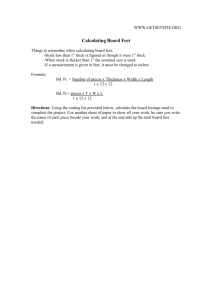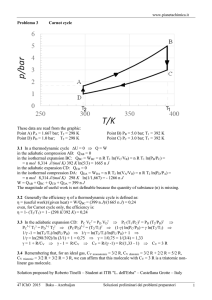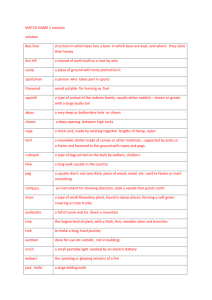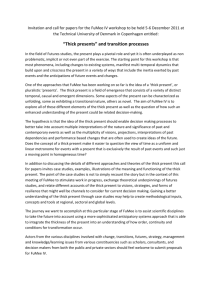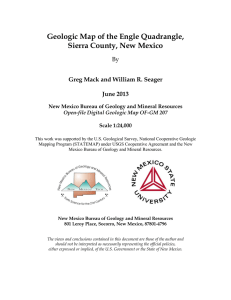Document 10907339
advertisement
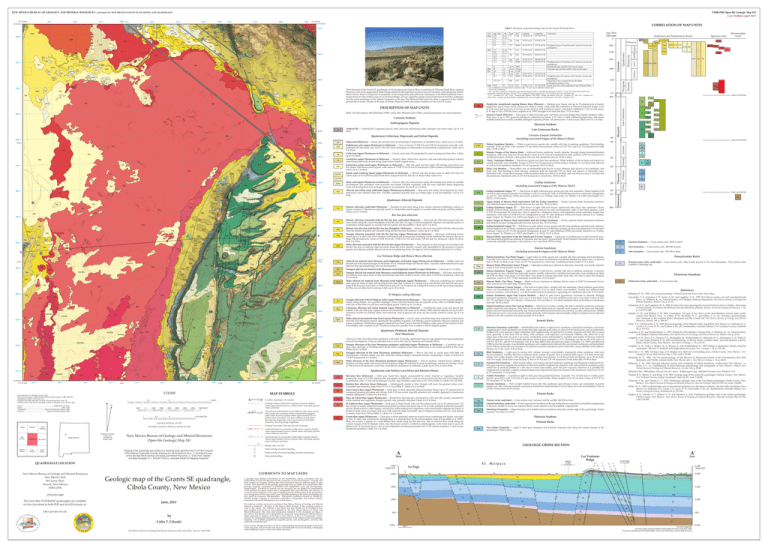
Qdf Qajy Qajy Qesd Qaec 3889000 Qes Qaec Qesd Qesd Qdf Qay Qah Qaec Qdf Qazo Qdf Qdf Qls 3888000 Qls Qafo Qafo Qajo 14 Qbc Qsw Qafh af 11 Kdc Kdou Qafo af Qafo 3888000 Qls Ttbp Qajo 1 Kdp Qes Kmw Qajy Qbg Qajhf Qbc Qbc Qes Kdc 77 Kdol Qafo Qajo Qajy Qajhf Qajo Qajh Qafy 3887000 Note: Soil descriptions after Birkeland (1999), colors after Munsell Color (1994), and all proportions are visual estimates. Qajh Qafh Qajhf Qbc Qls Qbc L94 35°05.16’N 107°46.52’W DP04 34°55.97’N C L94 35°00.32’N 107°50.45’W Weighted mean of 0 mm/kyr and 5 mm/kyr erosion rate assumptions 108°04.35’W 3 He L94 34°59.64’N 108°05.22’W 3 36 He Cl L94 DP04 34°59.57’N 34°59.55’N 7 14 33 50 3.0 Ar/Ar Ar/Ar K-Ar K-Ar 36 Cl M94 LWup CL88 L93 35°07.52’N DP04 35°04.49’N 108°05.48’W 108°05.30’W Weighted mean of 0 mm/kyr and 5 mm/kyr erosion rate assumptions Inconsistent age, possibly from excess argon Uncertain age, possibly suffers from excess argon 115-120 -- PM C97 3238 85 K-Ar L93 35°05.17’N Anthropogenic Deposits Qafh Qls Kdp 3886000 Qbc af Kmw Qbm Qbc Jm 3886000 af Kdol 4 05'00" Qay Qbc Qbg 5 af Qajh 3 Qes Qay Qdf 3885000 8 Qafo Qbc Qbc Qbm Qes Qdf Qdf Jt Js Qafy Qbc Qdf Qafo 3884000 Qbg Js Qbc Kdol Qc Qes Qbm Qbc Qes Qesd Qafy Qdf 3883000 Jm Kdou Qc Kdol Jb Jm af 4 Kdol Kdou Qay af af Qpy ^c Qpy3 Psa af Qdf Qpo Qbm Qbc ^m Psa Qpo Qesd Qes/Qbc Qdf Qbc Kdp Qafo Qbg Kmc Jb 1 Kdol 64 Kmc Qls Jb Qafo Qaf Qls 2 Qes Qafo Qbc 1 Qls Qae Qesd Qes Qdf Kdc Kmw Qae Kdp Qay Jb Kdol Qls Qls Qae ? Qbc Qbc Qls Kmc Kmc Kdc Kdp Kmc Kdp Qls Qay Qay 4 Kdt Kdc Qaec 4 Qbb Kdp Qafy Qes/Qbc Kdc Qbh Qes/Qbc Jb 3879000 af Qes Qafo Kdt Qbc Qbc Qes/Qbh Qae Qbc Qesd Qbm Kmc Qbb Kdp Qafo Qes/Qbc Kdol Qbc 3878000 Kdc Kmc Qay Qbh Qafy Qay Qay 35°00'00"N 107°52'30"W 238000 240000 239000 241000 242000 50'00" Kmw Kdt Tib Kdol Qae Qesd 3 Kdp Kdp Kmc 243000 Kmw Kmc Kdp Qesd Qes Kdt Kdt Qae 3877000 Qpo Kmrd Kdp Qls Qes Qae Qae 245000 47'30" 244000 Kmw Kmrd Qbm Qae 247000 246000 35°00'00"N 248000 107°45'00"W Qbb MAP SYMBOLS 1:24,000 Base map from U.S. Geological Survey 2010. North American Datum of 1983 (NAD83) World Geodetic System of 1984 (WGS84). Reprojected to NAD27, UTM Zone 13S. Projection and 1000-meter grid: Universal Transverse Mercator, Zone 13S 10 000-foot ticks: New Mexico Coordinate System of 1983(west zone), shown in blue. 1 0.5 0 1 MILE A A' ! Roads...........................................................................©2006-2010 Tele Atlas Names.............................................................................................GNIS, 2008 Hydrography............................................National Hydrography Dataset, 2005 Contours........................................................National Elevation Dataset, 2000 ! MN 1000 0 1000 2000 3000 4000 5000 6000 7000 FEET 73 71 ! 1 0.5 0 ! ! 1 KILOMETER CONTOUR INTERVAL 20 FEET MILAN SAN RAFAEL GRANTS SE NEW MEXICO MCCARTYS Magnetic Declination August, 2012 9.57498º East At Map Center New Mexico Bureau of Geology and Mineral Resources Open-file Geologic Map 241 Tib ARROSA RANCH LOS PILARES CROW POINT Mapping of this quadrangle was funded by a matching-funds grant from the STATEMAP program of the National Cooperative Geologic Mapping Act, administered by the U. S. Geological Survey, and by the New Mexico Bureau of Geology and Mineral Resources, (L. Greer Price, Director and State Geologist, Dr. J. Michael Timmons, Associate Director for Mapping Programs). ! ! ? ! ! ! ? ! Qbh Geologic contact. Solid where exposed or known, dashed where approximately known, dotted where concealed; queried where uncertain. Qbc Normal fault, ball-and-bar on downthrown side, shear arrows show strike slip movement where interpretation suggests. Solid where exposed, dashed where approximately known, dotted where concealed. Tick gives attitude of fault plane, showing dip magnitude, arrow gives trend of fault plane lineations, showing plunge magnitude. Anticlinal bend of a monocline, Solid where exposed, dashed where approximately known, dotted where concealed, queried where existence uncertain. [575] 835-5490 This and other STATEMAP quadrangles are available for free download in both PDF and ArcGIS formats at: June, 2013 http://geoinfo.nmt.edu by Colin T. Cikoski New Mexico Bureau of Geology and Mineral Resources, 801 Leroy Place, Socorro, NM 87801 Mancos Shale, Clay Mesa Tongue — Black to brown claystone to siltstone. Brown color of 10YR 5/4 measured; brown color may be an iron oxide stain. 18-24 m thick. Kdc Dakota Sandstone, Cubero Tongue — Pale brown to light yellow variably silty fine sandstone. Thinly bedded, particularly where not bioturbated (30-50 cm thick where massive, 2-12 cm thick where cross-bedded). Vertical and subhorizontal burrows common. Unit includes a ~2 m thick medial section of mudstone, separating two sandstone intervals. 9-12 m thick. Younger alluvium of the Zuni Mountains piedmont, undivided (upper Pleistocene to Holocene) — Combined unit of Qpy1, Qpy2, and Qpy3 of Timmons and Cikoski (2012), mapped where finer subdivision is not readily possible at this scale. Likely up to 3 m thick. Qbg Kmm Kcs Kcdi Kgc Kge Km Kmrd Kmw Kdp Kmc Kd Kdc Kdou Kdol Jm Jb Js Jt Je 201 252 ^u 323 ^c ^m Psa Pg Py Pa *u major unconformity 541 2500 Xu Pg Glorieta Sandstone — Cross section only. 40-45 m thick. Py Yeso Formation — Cross section only. 380-385 m thick. Pa Abo Formation — Cross section only. 285-290 m thick. Pennsylvanian Rocks Pennsylvanian rocks, undivided — Cross section only. Only locally present in the Zuni Mountains, ~150 m thick in the Gottlieb #1 lithologic log. *u Proterozoic Eonothem Proterozoic rocks, undivided — Cross section only. Xu References Birkeland, P. W., 1999, Soils and geomorphology: Oxford University Press, New York, 430 p. Cascadden, T. E., Geissman, J. W., Kudo, A. M., and Laughlin, A. W., 1997, El Calderon cinder cone and associated basalt flows: in: Maberry, K., ed., Natural history of El Malpais National Monument, New Mexico Bureau of Geology and Mineral Resources, Bulletin 156, p. 41-51. Champion, D. E., and Lanphere, M. A., 1988, Evidence for a new geomagnetic reversal from lava flows in Idaho – discussion of short polarity reversals in the Bruhnes and late Matuyama polarity chrons: Journal of Geophysical Research, v. 93, p. 11,667-11,680. Dunbar, N. W., and Phillips, F. M. 2004. Cosmogenic 36Cl ages of lava flows in the Zuni-Bandera volcanic field, northcentral New Mexico, USA: in: Cather, S. M., McIntosh, W. C., and Kelley, S. A., eds., Tectonics, geochronology and volcanism in the southern Rocky Mountains and Rio Grande rift, New Mexico Bureau of Geology and Mineral Resources, Bulletin 160, p. 309-317. Kelly, T. E., and Reynolds, C. B., 1989, Structural geology of the Malpais Valley, San Rafael, New Mexico: in: Anderson, O. J., Lucas, S. G., Love, D. W., and Cather, S. M., eds., Southeastern Colorado Plateau, N.M. Geological Society, Guidebook 40, p. 119-121. Laughlin, A. W., and WoldeGabriel, G., 1997, Dating the Zuni-Bandera volcanic field: in: Maberry, K., ed., Natural history of El Malpais National Monument, New Mexico Bureau of Geology and Mineral Resources, Bulletin 156, p. 25-29. Laughlin, A. W., Perry, F. V., Damon, P. E., Shafiqullah, M., WoldeGabriel, G., McIntosh, W. C., Harrington, C. D., Wells, S. G., and Drake [Drakos], P. D., 1993, Geochronology of Mount Taylor, Cebollita Mesa, and Zuni-Bandera volcanic fields, Cibola County, New Mexico: New Mexico Geology, v. 15, p. 81-92. Laughlin, A. W., Poths, J., Healey, H. A., Reneau, S., and WoldeGabriel, G., 1994, Dating of Quaternary basalts using the cosmogenic 3He and 14C methods with implications for excess 40Ar: Geology, v. 22, p. 135-138. Maxwell, C. H., 1986, Geologic map of El Malpais lava field and surrounding areas, Cibola County, New Mexico: U.S. Geological Survey, Miscellaneous Map I-1595, scale 1:62,500. McIntosh, W. C., 1994, 40Ar/39Ar geochronology of late Miocene to Pleistocene basalts of the Zuni-Bandera, Red HillQuemado, and Potrillo volcanic fields, New Mexico (abs.): New Mexico Geology, v. 16, p. 60-61. Summerville Formation — White to pale yellow, very poorly exposed sandstone, mudstone, and limestone conglomerate(?). One poor exposure suggests the presence of limestone pebble conglomerate channels, with subrounded to rounded, poorly sorted fine to medium pebbles in a silty fine to coarse sand matrix; given the poor exposure, however, it is possible this conglomerate is actually a caliche-cemented Quaternary deposit inset upon the Summerville sandstones. Colors of 2.5Y 8/1 to 7/3 measured. 13-16 m thick. Js Molenaar, C. M., 1983, Principal reference section and correlation of Gallup Sandstone, northwestern New Mexico: in: Hook, S. C., ed., Contributions to mid-Cretaceous paleontology and stratigraphy of New Mexico – Part II, New Mexico Bureau of Geology and Mineral Resources, Circular 185, p. 29-40. Munsell Color. 1994 edition, Munsell soil color charts: Kollmorgen Corp., Macbeth Division, New Windsor, N.Y. Thaden, R. E., Merrin, S., and Raup, O. B., 1967, Geologic map of the Grants SE quadrangle, Valencia County, New Mexico: U.S. Geological Survey, Geologic Quadrangle Map GQ-682, scale 1:24,000. Todilto Formation — Gypsiferous light to dark gray fine-grained limestone. Typically <5% of fresh faces is visible grains (locally up to 20%), with <1-2% fine (<1 mm across) circular fossils. Thinly bedded, 0.5 to 10 cm thick. Colors of 2.5Y 6/1 to 7/1 measured. 5-7 m thick. Jt Timmons, J. M., and Cikoski, C. T., 2012, Preliminary geologic map of the San Rafael quadrangle, Cibola County, New Mexico: New Mexico Bureau of Geology and Mineral Resources, Open-file Geologic Map OF-GM-232, scale 1:24,000. Entrada Sandstone — Pink to light reddish brown silty fine sandstone and siltstone. Grains are moderately to poorly sorted, very silty with rare medium sand grains. Indistinctly thinly bedded (2-10 cm thick), but well cross-bedded. Color of 2.5YR 7/4 measured. 45-50 m thick. Je Zuni Canyon flow (upper Pleistocene) — Dark gray to black, generally phenocryst-poor basalt. Up to 3% phenocrysts of translucent greenish pyroxene and olivine, both <1/2 mm across, typically anhedral, and variably degraded to translucent reddish iddingsite(?). Likely 0 to 4 m thick. White, W. D., 1989, Geohydrologic and environmental indicators of a dewatered wetland: Ojo del Gallo, San Rafael, New Mexico: in: Anderson, O. J., Lucas, S. G., Love, D. W., and Cather, S. M., eds., Southeastern Colorado Plateau, New Mexico Geological Society, Guidebook 40, p. 337-345. Triassic Rocks El Calderon flow (upper Pleistocene)— Dark gray to black basalt with rare fine phenocrysts. Up to 5% phenocrysts <1/2 mm across of mainly subhedral translucent greenish pyroxene and lesser (up to 1% of rock) anhedral translucent greenish olivine. Basalt surface is often largely concealed by eolian material and vegetation, with actual basalt cropping out mainly at breaks in slope, areas of erosion, and areas with relatively high microrelief. Age of eruption uncertain due to a wide spread in results, from 34 to 130 ka (Table 1). Likely 0 to 7 m thick. Zeigler, K. E., Cikoski, C. T., Drakos, P. D., and Riesterer, J., 2012, Preliminary geologic map of the Grants quadrangle, Cibola County, New Mexico: New Mexico Bureau of Geology and Mineral Resources, Open-file Geologic Map OF-224, scale 1:24,000. ^u Triassic rocks, undivided — Cross section only. Includes both ^c and^m. 540-550 m thick. ^c Chinle Formation, undivided — Poorly exposed red mudstone at the top, reddish brown sandstone and pebble conglomerate at the base; middle of unit is not exposed. Basal contact placed on the first pebble conglomerate. ^m Moenkopi Formation — Slope-forming red to reddish brown mudstone along the eastern edge of the quadrangle. Poorly exposed. Less than 5 m thick. Paleozoic Erathem Grants flow (upper Pleistocene) — Dark gray to black generally phenocryst-poor basalt underlying and largely concealed by Qbc. To date, only conclusively distinguished as a separate flow by the paleomagnetic work of Cascadden et al. (1997). Here, the contact is placed on a well-defined flow break along the Rio San Jose, and an inferred flow break along the western margin of the El Malpais valley; only the former contact is verified by paleomagnetic work. Rock mass is up to 4% phenocrysts of pyroxene (up to 1 mm across, subhedral, translucent greenish) and <1-2% olivine (euhedral, <1 mm across, translucent greenish). Likely 0 to 7 m thick. Permian Rocks San Andres Formation — Light to dark gray limestone and dolomite. Exposed only along the eastern margin of the quadrangle. 75-80 m thick. Psa GEOLOGIC CROSS SECTION Basaltic dike, unit Tib. 4 Strike and dip of inclined bedding. 2 Strike and dip of inclined bedding, remotely determined. A COMMENTS TO MAP USERS A geologic map displays information on the distribution, nature, orientation, and age relationships of rock and deposits and the occurrence of structural features. Geologic and fault contacts are irregular surfaces that form boundaries between different types or ages of units. Data depicted on this geologic quadrangle map are based on reconnaissance field geologic mapping, compilation of published and unpublished work, and photogeologic interpretation. Locations of contacts are not surveyed, but are plotted by interpretation of the position of a given contact onto a topographic base map; therefore, the accuracy of contact locations depends on the scale of mapping and the interpretation of the geologist(s). Any enlargement of this map could cause misunderstanding in the detail of mapping and may result in erroneous interpretations. Site-specific conditions should be verified by detailed surface mapping or subsurface exploration. Topographic and cultural changes associated with recent development may not be shown. The map has not been reviewed according to New Mexico Bureau of Geology and Mineral Resources standards. Revision of the map is likely because of the on-going nature of work in the region. The contents of the report and map should not be considered final and complete until reviewed and published by the New Mexico Bureau of Mines and Mineral Resources. The views and conclusions contained in this document are those of the authors and should not be interpreted as necessarily representing the official policies, either expressed or implied, of the State of New Mexico, or the U.S. Government. Crosssections are constructed based upon the interpretations of the authors made from geologic mapping, and available geophysical (regional gravity and aeromagnetic surveys), and subsurface (drillhole) data. Cross-sections should be used as an aid to understanding the general geologic framework of the map area, and not be the sole source of information for use in locating or designing wells, buildings, roads, or other man-made structures. El La Vega 2,000 Qbg? Qa Psa Qbm Qa Qa ? ^u Pg Py Psa Pg Pa *u Py ? Pa Jb Kdou Jm Kdol Jm Qa Je Kdou Kdc Jm Jb Kmc Kdp Kdc Kdol 2,000 Js Jt ^u 1,500 Psa Psa Pg Py 1,000 Pa *u Pa Pa *u Xu *u Xu 500 m Js Py Xu 0 MSL Kdou Pg Pa *u 500 2,300 meters ASL ^u Pg Py 1,000 ^u Psa Py Pa *u fault terminates in a monocline Je Psa Pg 1,500 Qbc Kmc Kdp Kdc Kdc Kdou Kdou Kdol Jm Kdol Jb Js Jt Je Jt Je East ^u Psa Py Qbc Qbc Qa ^u Pg Bend in section S87W N90E Malpais A' Las Ventanas Ridge West Horizontal bedding. Tib Kdt Bluff Sandstone — Light gray to strong olive colored, strongly cross-bedded, dominantly eolian sandstone with local fluvial sandstone. Variably silty fine to medium sands, mainly of quartz. Thin to medium beds (up to 1.5 m thick observed), tabular and wedge-shaped, with steep, large-scale, eolian cross-laminae. Local fluvial beds are thinner, up to 20 cm thick, with low-angle, small-scale cross-laminae. Colors of 5Y 8/2 and 2.5Y 6/6 measured. Forms bold cliffs. 85-90 m thick. Jb Hoya de Cibola flow (upper Pleistocene) — Basalt flows burying Qbc, and buried by Qbm and Qbb, locally concealed by eolian material and vegetation though typically only partially concealed. Likely 0 to 5 m thick. Qafo Qazo Qpo Kmg1 Morrison Formation, undivided — Interbedded pale yellow to light brown sandstone, varicolored mudstone, and lesser conglomerate. Lower sandstones are of silty fine sand, typically pale yellow in color (2.5Y 8/3 measured), and are indistinctly bedded with cross-laminae. Upper sandstones and conglomerates are pale brown to white, of quartz-rich silty fine to coarse sand, generally in thin beds (5-8 cm thick) with common, well-expressed cross-laminae. Pebbles, only observed in the upper part of the unit, are up to 1 cm across, moderately sorted, subrounded to rounded, and mainly of siliceous material with rare granites (up to 2% of beds) and sparse white to gray quartzites (<<1%). Mudstones are clay to silt, with colors of 5YR 5/3, 5GY 8/1, and 5Y 8/2 measured. Use of Jm here differs from the previous maps of Thaden et al. (1967) and Maxwell (1986) in that the strongly cross-bedded sandstones and conglomerates between the varicolored mudstones and bioturbated lower Dakota sandstones are included in the Morrison and not considered a part of the Oak Canyon Member of the Dakota. Pinches out to the south. 0-30 m thick. Jm Bandera flow alluvium (lower Holocene) — Lithologically similar to Qbm, though with more fine-grained eolian cover. Consistent age estimates range from 9.17 to 12.5 ka (Table 1). Likely 0 to 6 m thick. Qc Kgf Jurassic Rocks McCartys flow (Holocene) — Dark gray basalt flow largely unconcealed by eolian material or vegetation. Variably porphyritic, from <1% to 20% phenocrysts, principally of subhedral, <1 mm across pyroxene, but also rare (<3%) plagioclase as subhedral, clear, <1 mm across prismatic crystals. Age estimates range from 2.4 to 3.9 ka (Table 1). Likely 0 to 6 m thick. Qbc Kmg2 Dakota Sandstone, lower Oak Canyon Member — Pale brown to white, variably silty fine to medium sandstone and lesser pebbly sandstone and siltstone. Thin beds (1-10 cm thick beds) that are typically more massive at the base and internally planar and cross-laminated toward the top. Vertical and subhorizontal burrows are common. Locally carbonaceous. Pebbles at the base are up to ½ cm across, poorly sorted, generally well rounded, and principally of light to medium brown siliceous material with rare quartzite and sparse granite. 8-10 m thick. Kdol Older alluvium of the Zuni Mountains piedmont (upper Pleistocene) — Pale to medium reddish brown pebbles to boulders and silty sands with strong soil development. Stage III carbonate horizon morphology common in outcrop. Colors of 5YR 5/4 to 8.5/2 measured, with color controlled by abundance of carbonate. Likely up to 10 m or more thick. Qsw Qls Kg Dakota Sandstone, upper Oak Canyon Member — Black to pale brown gypsiferous claystone to siltstone. Strongly laminated mudstone, commonly wavy, up to 4 mm thick. Local very fine sandstone beds up to 3 cm thick. Colors of 2.5Y 5/3, 7/2, and black (value <2.5, chroma ~1) measured. Unit includes a ~2 m thick sandstone interval dividing two mudstone intervals. 26-30 m thick. Older alluvial fan material from Zuni Canyon (Pleistocene) — Gravel, sand, and silt bearing clasts indicative of derivation from the Zuni Mountain interior, specifically fine pebbles of granite, red siltstone, quartz sandstone, siliceous material, and arkosic sandstone. Distribution suggests transport from Zuni Canyon into the El Malpais valley prior to the eruption of Qbz but probably after eruption of Qbc. Thickness unknown, possibly tens of meters in the El Malpais graben. 2,300 meters ASL Geologic map of the Grants SE quadrangle, Cibola County, New Mexico Kmc Younger alluvium of the El Malpais valley (upper Pleistocene to Holocene) — Fine sand and mud with local fine pebbles, mainly along shallow, low gradient drainages. Active soils and buried soils are typically weak, A/Bw to A/Bt/Bk (Stage I), with clay as fine films on ped faces and bridging grains. Likely up to 2 m thick. Youngest alluvium of the Zuni Mountains piedmont (Holocene) — Brown silty fine to coarse sand with little soil development. Contains sparse very fine carbonate nodules (Stage I carbonate horizon morphology). Colors of 5YR 6/4 to 7.5YR 5/3 measured. 0-1 m thick. Qbh Qbg Dakota Sandstone, Paguate Tongue — Light yellow to pale brown, variably silty fine to medium sandstone. A massive base grades up into a bedded but internally massive middle, followed by a bedded and internally cross-stratified top. Beds are 4-20 cm thick, cross-strata 1-12 mm thick. Unit tends to coarsen upsection, from silty very fine to clean fine-medium sandstone. Colors of 2.5Y 7/3-8/3 measured on fresh faces. 9-12 m thick. Kdou Calcareous alluvium and eolian material (upper Pleistocene to Holocene) — Fossiliferous sand, mud, and sparse fine pebbles with rare dark gray organic material accumulations. Soil analyzes by White (1989) indicate deposits are up to 100% carbonate. Fossils are mollusk shells, and carbonate casts of grasses and roots are also locally common. Likely up to 3 m thick. Qajo Synclinal bend of a monocline, Solid where exposed, dashed where approximately known, dotted where concealed, queried where existence uncertain. QUADRANGLE LOCATION New Mexico Bureau of Geology and Mineral Resources New Mexico Tech 801 Leroy Place Socorro, New Mexico 87801-4796 Qbz Location of geologic cross section. Exposed monocline, showing direction of plunge. NATIONAL GEODETIC VERTICAL DATUM OF 1929 LOBO SPRINGS GRANTS Kmw Mancos Shale, Whitewater Arroyo Tongue — Light gray to dark gray siltstone to claystone. Generally very poorly exposed. Color of 2.5Y 7/2 measured. 4-6 m thick Quaternary and Tertiary Lava Flows and Intrusive Rocks Kdt Kmw Kmw Kdp 3 Kdol Jb Qae Kdt Kmw Jb Qbm Qes Qbc Qes Qbc Qpy Qpy3 Kdt Kdp Qafy Qes Qbc Qbh Qae Qes Kmw Jb Kdou 3877000 Kmw Qesd af Qesd Kdc Kdol Qbc Qes Qbh Qls Qae Qafo Qbc Kdt Kdp af Qes/Qbc Kmw Dakota Sandstone, Two Wells Tongue — Light yellow to white, quartz-rich, variably silty fine sandstone and local siltstone. Typically more massive and thicker bedded base, and more cross-bedded and thinner bedded top. Beds from 1 m thick at base to 25-40 cm thick at top. Color of 2.5Y 7/4 measured on a fresh face. Gradational basal contact. 9-11 m thick. Alluvium of the Zuni Mountains piedmont, undivided. Typically subdivided based on age inferred from geomorphology and soil development. Units are extended from work to the west by Timmons and Cikoski (2012). Qes Qaf Qaf Qes/Qbc Qbc Qbb 3878000 Kdc Qae Jb Qes Qbc Qay Kdp Kmc Qafy Older alluvial fan material from Mezosoic-cored highlands (upper Pleistocene) — Alluvium underlying fan surfaces inset upon by those of Qafy and bearing buried soils and evidence of a strong active soil. Buried soils have Bt and up to Stage II Bk horizons and colors of 10YR 6/3-6/4 and 2.5Y 7/4. Evidence for a Stage III K horizon at the top of these deposits, but this was not observed in outcrop. Likely up to 10 m thick. Quaternary Piedmont Alluvial Deposits Zuni Mountains Kmc Kdp Qafo Qbc Qes Qaf 5 af Qbc Kdou Tib Kmw Kdou Qbc Kdt Kmw 4 Kmc Qay 4 Kdp Qes/Qbc Qdf Kmc Kmc Tib Kdp Kmw Qazo 6 16 Qes Qbc Qdf Qae Qes Kmc Kdp Kmc Qay Qbc Qdf Qbc 3879000 Kdt Kdp El Malpais valley alluvium Kdc Kmc Kmc Kdp Qls Kmw 5 Kmc 2 Qls Kmc Kdp Kdol Younger alluvial fan material from Mezosoic-cored highlands (upper Pleistocene to Holocene) — Alluvium underlying fan surfaces inset upon those of Qafo and bearing weak soils (A/Bw at most), with colors of 10YR 6/3 measured. Likely up to 6 m thick. 3880000 4 Kdc Qafy Qafo Qaf Kmc Qdf Kdc Qay Kdc 11 13 Qay Tib Kdc Kdou Qaf Youngest alluvial fan material from Mesozoic-cored highlands (middle to upper Holocene) — Likely up to 1 m thick. Qbz major unconformity Dakota Sandstone (including associated tongues of the Mancos Shale) Alluvial fan material from Mezosoic-cored highlands, undivided (upper Pleistocene to Holocene) — Pebbly sand and silt derived from small drainages in the flanks of Las Ventanas Ridge and Horace Mesa. Typically subdivided based on age inferred from geomorphology and soil development. Qbb Qesd Qdf Ttbp 145 Mancos Shale, equivalent to the Rio Salado and D-Cross Tongues — Light gray to medium gray to pale brownish gray, well-laminated gypsiferous siltstone to claystone and rare sparry gypsum beds. Thinly bedded, with beds up to 6 cm thick, commonly internally laminated, with laminae <1 to 1 mm thick. 45-55 m thick. Kmrd Older alluvium associated with the Rio San Jose (upper Pleistocene) — Thin deposits of sand and gravel associated with the Rio San Jose at relatively high elevations along the active channel. Largely only identifiable by the presence of sparse granitic and siliceous pebbles that do not occur in underlying strata. No signs of soil development observed. 0-1 m thick. Qafh Kdc 2 Qls Qls Qaf Qafo Kdou Kdou Kdc 1 af Qafo 3881000 02'30" Kdou Qaf Kdou Kdc Kmc Kmc Kmc Kdt Kmc Qaec Qae Qes Gallup Sandstone tongue “F” — Pale brown to pale yellow to gray quartz-rich silty fine sandstone and fine sandy siltstone. Thinly bedded (4-30 cm thick), commonly massive with burrows at the base, grading up into cross-laminated (1-4 mm thick laminae). Colors of 2.5Y 7/1-8/3 measured. Designation as unit “F” after Molenaar (1983), previously referred to as “Gallup, lower tongue” by Thaden et al. (1967) and Zeigler et al. (2012). 12-15 m thick. Kgf Younger alluvium associated with the Rio San Jose (upper Pleistocene to Holocene) — Alluvium underlying terrace treads up to 2 m above the active channel, with typical soil development including a weak reddened Bw horizon and up to Stage I Bk development. Colors of 10YR 5/4 to 5/6, 7.5YR 5/3 to 5/4, and locally 5YR 4/4 and 7/4, measured. Likely not more than 3 m thick. Qbm Lower tongue of Mancos Shale intercalated with the Gallup Sandstone — Poorly exposed, thinly laminated mudstone and siltstone located stratigraphically between Kgf and Kge. 10-15 m thick. Las Ventanas Ridge and Horace Mesa alluvium Kdc Qls Qaf 2 Kdc Qbm Qls Qaf Kdou Kdou Kdou Qay Qbg 1 Kdol 8 7 Kdol Kdol Qae 63 Kdou Kdc Kdp af Kdou Kdol Qay Qajy Kdou Kdc Kdol 83 Kdc Kmc Qbb Qes Qajhf Qajy Qay Qpy Kc Upper tongue of Mancos Shale intercalated with the Gallup Sandstone — Poorly exposed, thinly laminated mudstone and siltstone located stratigraphically between Kge and Kgc. 30-36 m thick. Gallup Sandstone tongue “E” — Pale brown to light yellowish brown, quartz-rich silty-clayey fine sandstone. Thinly bedded (3-50 cm thick), massive with vertical tubular burrows to well cross-laminated, with 1-3 mm thick laminae. Color of 2.5Y 8/4 measured for a fresh face. Unit is capped by a distinctive brown, well indurated, calcite-cemented, muddy fine sandstone, with colors of 10YR 5/4 to 6/3. Designation as unit “E” after Molenaar (1983), previously referred to as “Gallup, upper tongue” by Thaden et al. (1967) and Zeigler et al. (2012). 15-25 m thick. Qajh Qajhf Qpy3 Metamorphic rocks major unconformity 299 Gallup Sandstone tongue “C” — Pale brown to light yellowish gray quartz-rich silty fine sandstone. Thinly bedded (5-30 cm thick) with common internal cross-laminae 1 mm to 1 cm thick. Color of 10YR 8/4 measured for a fresh face. Designation as unit “C” after Molenaar (1983), previously referred to as “Gallup, main body” by Thaden et al. (1967) and Zeigler et al. (2012). 12-20 m thick. Kgc Historic fan alluvium with the Rio San Jose floodplain (Holocene) — Historic alluvium associated with thin alluvial fans from the termini of gullies and channels along the Rio San Jose floodplain. Likely up to 1 m thick. Kdou af Jb Kdol Kdou 2 Qafo Qpo Qbc 66 Kdou 63 86 Qes/Qbc Qpy Kmc Qls 62 Kdol Qafy Qpy 3880000 Alluvial and eolian sand, undivided (upper Pleistocene to Holocene) — Silty sand and sandy silt transported by wind, slopewash, and confined water flow. Variably vegetated, typically does not exhibit signs of soil development. <1/2 to 2 m thick. Kgm1 Qajo Kdc Qls Kdol Kmc Qafo Qbg Qbc Kdou A' Kdol af Kdol Kdp Kdc Kdou Qafo 79 Kdc Kdou 63 02'30" Qpy3 4 Kdou Kdp Qafo 3881000 Gallup Sandstone (including associated tongues of the Mancos Shale) Qes/Qbc Qbc Qbg Kdou 4 Kmc Dune sand (upper Pleistocene to Holocene) — Clean to silty fine sand and fine sandy silt forming dune forms of variable development and sandsheets with mounded microrelief. Variably vegetated, with the more vegetated dunes displaying weak soil development such as Stage I gypsum accumulation. As much as 5 m thick. Historic alluvium associated with the Rio San Jose, undivided (Holocene) — Sand and silt with lesser gravel and rare clays found along the current floodplain of the Rio San Jose. No sign of soil development. Deposits are typically poorly to moderately sorted angular to rounded silt/sand grains and fine pebbles. Likely up to 1 m thick. Qaf Qaf Kdc Kdc Qafo Qay af Qls 71 Kdol 62 2 Qafy Eolian sand overlying basalt (upper Pleistocene to Holocene) — Hybrid unit that locates areas of either the Hoya de Cibola (Qbc) or El Calderon (Qbh) basalt flows largely buried by thin (0-1 m thick) eolian sand cover. Qafh Qafy Igneous rocks Kcda 100 Dilco Coal Member — Heterolithic unit of interbedded pale brown to gray siltstone, pale brown to tan sandstone, and black coal. Thin bedding to thick laminae; sandstone beds are typically 5-25 cm thick and massive or internally crosslaminated with 1-4 mm thick laminae, while mudstone beds are 3 mm to 3 cm thick, and coal beds are up to 1 cm thick and discontinuous. Sandstone color of 2.5Y 8/4 measured on a fresh face. 35-45 m thick. Kcdi Qajh af Qaf Kdc 73 Jb Qafo Qdf Qdf Qpo 2 Kdou Qafo Qay Qdf Kdou 3 4 Kdol Je Qbc ^m ^c Jm Qdf Qpo Qpy Qafo Qes Qbc Quaternary eolian sand (upper Pleistocene to Holocene) — Silty fine sand and fine sandy silt forming sand sheets and low dunes. Pale brown colors typical, with colors of 7.5YR 7/3 to 7/6 and N 9 measured. Little evidence of soil development. Likely up to 2 m thick. af 66.0 “Stray” Sandstone Member — Pale brown quartz-rich clean fine sandstone. Thinly bedded, 10-40 cm thick, and massive to weakly internally cross-stratified. Colors of 2.5Y 8/3 to 7/4 measured on fresh surfaces. Includes a 2-3 m thick shale interval, as well as local mudstone interbeds (<5% of exposures). 20-25 m thick. Kcs Rio San Jose alluvium Qaf Qae Kdc 5.3 Kmm Kge Qafo Qdf Qpy3 Kdol Qls Kdc Kdou Qbc Qpy Qafh 2.59 Mulatto Tongue of the Mancos Shale— Yellowish brown mudstone, mostly siltstone. Strongly planar laminated/bedded mudstone, with wavy beds 2 to 30 mm thick. Colors of 2.5Y 7/4 to 8/3 measured for fresh surfaces, 10YR 7/6 measured for weathered surface. Includes a thin quartz-rich very fine sandstone interval. 50-60 m thick. Historic alluvium, undivided (Holocene) — Boulders to fine sand along active stream channels exhibiting evidence of historic transport. Deposits are typically poorly to moderately sorted angular to rounded silt/sand grains and fine pebbles. Likely up to 1 m thick. Qah Qay af Kdol 3883000 Qafh Qbc Jm Qafo Qafo Qbc 1.806 Dalton Sandstone Member — White to pale brown quartz-rich, variably silty fine to medium sandstone. Thin bedding, typically 10-60 cm thick, with common 1-5 mm thick cross-laminae. Colors of 2.5Y 8.5/1 and 2.5Y 7/2 measured for fresh faces. 34-40 m thick. Quaternary Alluvial Deposits Qaf Kdc Qesd Kdc Qls Kdol Qls Kdol Kdou Jm Jb Qay Qaf 0.781 Kcda Kgm2 Jb Qafo Jt Jb 3 Jt Qesd Jm Kdc 10 Qls Jm Jb Js Qdf Kdou Qae Js Qdf 3884000 Kdou Kdou Kdol Js Qafo Kdol Kdc 0.126 Qes/Qbh Kdol Qafo Jt Qls Jm Qafo Jt Qls Landslides (upper Pleistocene to Holocene) — Slumps, slides, debris-flow deposits, and associated fine-grained material underlying hummocky terrain along slopes below basalt-capped mesas. Qes/Qbc Qbc Qafo Jb Colluvium (upper Pleistocene to Holocene) — Gravel, sand, and silt transported by mass wasting and sheet flow. Likely up to 2 m thick. Qafh af 5 3 Qc Qajh Qay Je Qay af Qae Jm Je Deflationary pits (upper Pleistocene to Holocene) — Gray to brown (7.5YR 7/2 and 5YR 4/2 measured), generally welllaminated silt and lesser clay with 5-15% fine sand, subangular to subrounded, accumulating in depressions. Likely up to 2 m thick. Qes Qay Crevasse Canyon Formation (including associated tongue of the Mancos Shale) Qdf Qbm Je Qdf Qbc Kdol Jb Qafo Qbc Qafh 4 Quaternary Colluvium, Slopewash, and Eolian Deposits Slopewash (Holocene) — Sandy silt and silty sand accumulating in depressions in landslide areas. Likely up to 2 m thick. 3885000 Kmw Qafy 4 Qafo Qbc A Qajo 0.012 107°20.55’W 107°45.29’W Weighted mean of 0 mm/kyr and 5 mm/kyr erosion rate assumptions Suggested to have erupted during the Blake geomagnetic polarity event 107°42.50’W Lower lava flow from southeastern tip of Horace Mesa Late Cretaceous Rocks Qsw Kdt Qls Qay Kdou Kdc Qay Kdp Qbm Qae 05'00" Qes Kdou Jm Qbm Qajo Qbc Kdol 78 88 17 Holocene Artificial fill — Artificial fill. Compacted gravel, sand, and mud underlying roads, railroads, and water tanks. Up to 5 m thick. Qafy Qbc Qes 3882000 Qbm 0 Mesozoic Erathem af Qdf Sediments and Sedimentary Rocks (not to scale) Intrusive basalt (Pliocene) — Dark gray to dark brownish gray and black pyroxene-plagioclase basaltic porphyry dikes. Rock mass is up to 10% greenish-translucent subhedral pyroxene, 1-3% clear to white subhedral plagioclase, and sparse reddish translucent crystals, possibly iddingsite replacing olivine. All phenocrysts <1 mm across. Dikes are 0 to 1 m wide. Tid Cenozoic Erathem Qbc Longitude Comments 107°50.33’W Porphyritic trachybasalt capping Horace Mesa (Pliocene) — Medium gray basalt with up to 5% phenocrysts of mainly plagioclase (up to 6 mm across, translucent white to chalky white, lathe-like subhedral or fractured anhedral shapes, 2-4% of rock mass) and pyroxene (<1-6 mm across, black to dark translucent green, anhedral to subhedral, <1-2% of rock mass). K-Ar age of 3.24 ± 0.09 Ma from Laughlin et al. (1993) thought to be from this flow. 15-25 m thick. Ttbp DESCRIPTION OF MAP UNITS Qajy Latitude 34°56.01’N 2 Qafy Qajy 4 3887000 Qafy af Kdou Kdol Qafo Qafh Kdt Age (Ma) Ref.4 L94 : Age as published; no attempt made to normalize values. 14C ages are not calibrated calendar ages. : Uncertainty as published. 3 : PM – age from comparison of radiometric ages and paleomagnetic data to established paleomagnetic sequence; 14C ages date material from buried soils immediately underlying the flows; 3He and 36Cl are cosmogenic surface exposure ages; 40Ar/39Ar and K-Ar are crystallization ages. 4 : C97 – Cascadden et al., 1997; CL88 – Champion and Lanphere, 1988; DP04 – Dunbar and Phillips, 2004; L93 – Laughlin et al., 1993; L94 – Laughlin et al., 1994; LWup – Laughlin and WoldeGabriel, unpublished data, cited in Laughlin and WoldeGabriel., 1997; M94 – McIntosh, 1994. Chief elements of the Grants SE quadrangle. In the background, Horace Mesa is underlain by Pliocene basalt flows capping Mesozoic rocks from uppermost Chinle Group sediments through the Crevasse Canyon Formation. The hummocky terrain below Horace Mesa is comprised of landslides. In the foreground, pale yellowish sandstones of the Bluff Sandstone form a resistant base for the northern end of Las Ventanas Ridge, and are capped by poorly exposed Morrison Formation sediments and the basal sandstones of the Dakota Formation at the top. The Holocene McCartys lava flow is apparent in the middle ground left of center. Houses at the base of Horace Mesa lie within the eastern outskirts of the town of Grants. Qls Qafy Kmc Qesd 41 50 128 54 34.7 Qbh Qbc af Qes Qdf 14 Qafh Qbg Qdf 0.14 0.12 1.1 1.8 1.4 0.6 Qafo Qbg Qdf 9.17 9.81 11.0 10.0 12.5 11.2 Qafy Qajo Qbg Qbb 3889000 Qsw af Qajo Qdf Qaec 4 ±2σ 2 Type3 0.12 14C 0.14 3 1.1 He 0.6 36 1.2 Cl Kdt Qazo Qbg Kge af Qajy Qesd Qdf Qazo Qdf Kgc Kmrd Kdol Qes Qesd 3 Qls Qafo Qafo Qbg Qajh Qdf Kmrd Qafo Qajy Qay Kmg2 Qls Qafo Qajy Qay Kmg1 Kgf Unit Age1 (ka) Qbm 2.97 3.01 2.5 2.4 3.9 Kmw Qdf Qdf Qafy Kmm Kcdi Qafo 8 Qafy Qbc Qbg Qah Qesd Qdf Kmrd 17Kmc Kdp Qafh 5 6 Qafo af Qes Kcda Kcs Kge Qajhf Qay Qdf Qay Qbg Qls Jm Qajy af Kmw 4 Kmm Kdt Qajh Qdf Qaec Jb Kgf Kmrd Kdt Kdp Kmc 21 Kdc af Qes Qay Qbg Qes Qafh Qes Qajy Qbg Qay Qaec Kdol 11 27 Qbg Qdf Qafy Kmg1 Kgf 21 21 28 Jt af Kdt Kmrd 28 Kdou Js Qafo Qes Qes Qay Qesd Qah Qah Qbg Qdf Qes Qazo Qes Qes Qazo Qajy Qes Qafy af Qes 44 41 Je Kcdi Kmg2 CORRELATION OF MAP UNITS Table 1. Summary of geochronologic data for the Grants SE basalt flows. 3890000 middle upper Qbg Qafo Qajy af Qay Qesd Qdf ^c Kge Qls Kmw Qc Qls Qafo Kgc lower Qbz Qafh Qls 35°07'30"N Ttbp Kcda Kcs Gelasian Qah Qesd Kcdi Kmg2 Kmg1 Kmrd Pleistocene Qay Qbg Qesd Qah ^c Qafo Kdp Kdt Pliocene Qajy Qdf Je Qls Qafy Quaternary Qah Qes 3890000 Qajh Qes af Qaec Qah Neogene Qes Qesd af Late Cretaceous af Qajy 107°45'00"W 249000 248000 Jurassic Qes af 247000 246000 41 Qc Jt Js 34 Kdol Jm Qls Jb Qc Jb Triassic Psa Qpy 47'30" 245000 244000 Permian 243000 Penn. 50'00" 242000 241000 Cenozoic 240000 Mesozoic 239000 Paleozoic 107°52'30"W 35°07'30"N NMBGMR Open-file Geologic Map 241 Last Modified April 2013 A DIVISION OF NEW MEXICO INSTITUTE OF MINING AND TECHNOLOGY Proterozoic NEW MEXICO BUREAU OF GEOLOGY AND MINERAL RESOURCES ? Xu 500 *u Xu Xu No vertical exaggeration Subsurface geology beneath the Malpais basalts adapted from Kelly and Reynolds (1989). Pre-Jurassic unit thicknesses from Maxwell (1986), Timmons and Cikoski (2012), and the Gottlieb #1 core log. 0 MSL
